Identifying Problematic Soils Using Compressibility and Suction Characteristics
Abstract
1. Introduction
- H = Thickness of the soil layer.
- Ic = Collapse potential, determined using a predetermined applied vertical stress applied to a soil specimen taken from the soil layer as follows:Ic = 100 × (df − di)/ho
- di = Specimen height at the appropriate stress level before wetting.
- df = Specimen height at the appropriate stress level after wetting.
- ho = Initial specimen height.
- θ𝑠 = Saturated water content;
- 𝐴𝐸𝑉 = Air-entry value;
- θ𝑟1 = Residual water content;
- 𝑠𝑟1 = Residual suction;
- 𝑤p = Plastic limit;
- w𝑆ℎ = Shrinkage limit;
- PI = Plasticity index.
2. Materials and Methods
2.1. Materials
2.2. Testing Procedures
2.2.1. Swelling, Consolidation, and Collapse Potential Determination
2.2.2. Determination of Suction and Soil–Water Content Relationship
3. Results and Discussion
4. Conclusions
Author Contributions
Funding
Institutional Review Board Statement
Informed Consent Statement
Data Availability Statement
Acknowledgments
Conflicts of Interest
References
- Azam, S. Collapse and compressibility behaviour of arid calcareous soil formations. Bull. Eng. Geol. Environ. 2000, 59, 211–217. [Google Scholar] [CrossRef]
- Zheng, J.-L.; Zhang, R.; Yang, H.-P. Highway Subgrade Construction in Expansive Soil Areas. J. Mater. Civ. Eng. 2009, 21, 154–162. [Google Scholar] [CrossRef]
- Zheng, J.L.; Yang, H.P. Theory and Practice of Expansive Soil Treatment Technology; China Communication Press: Beijing, China, 2004. [Google Scholar]
- Katti, R.K. Search for Solutions to Problems in Black Cotton Soils. IGC Annual Lecture. Indian Geotech. J. 1979, 9, 1–80. [Google Scholar]
- Houston, S.L.; Dye, H.B.; Zapata, C.E.; Walsh, K.D.; Houston, W.N. Study of Expansive Soils and Residential Foundations on Expansive Soils in Arizona. J. Perform. Constr. Facil. 2011, 25, 31–44. [Google Scholar] [CrossRef]
- Sabtan, A.A. Geotechnical properties of expansive clay shale in Tabuk, Saudi Arabia. J. Asian Earth Sci. 2005, 25, 747–757. [Google Scholar] [CrossRef]
- Erol, O.; Dhowian, A.W. Swell and shrinkage behavior of medinah active clays. J. Eng. Sci. 1982, 8, 79–84. [Google Scholar]
- Abduljauwad, S.N. Swelling behaviour of calcareous clays from the Eastern Province of Saudi Arabia. Q. J. Eng. Geol. Hydrogeol. 1994, 27, 333–351. [Google Scholar] [CrossRef]
- Al-Muhaidib, A.I. Swelling Behaviour of expansive shales from the middle region of Saudi Arabia. Geotech. Geol. Eng. 1998, 16, 291–307. [Google Scholar] [CrossRef]
- Abduljauwad, S.N.; Al-Sulaimani, G.J.; Basunbul, I.A.; Al-Buraim, I. Laboratory and field studies of response of structures to heave of expansive clay. Geotechnique 1988, 48, 103–121. [Google Scholar] [CrossRef]
- Al-Muhaidib, A.I. Effects of fiber on swell of expansive soils. In Proceedings of the 20th International Offshore and Polar Engineering Conference, Beijing, China, 20–27 June 2010; pp. 20–25. [Google Scholar]
- Al-Muhaidib, A.I.; Al-Shamrani, M.A. Influence of swell on shear strength of expansive soil. In Proceedings of the GeoEng. Conference, International Society for Rock Mechanics, Melbourne, Australia, 19–24 November 2000. [Google Scholar]
- Al-Muhaidib, A.I. Characteristics of expansive soil in the Kingdom of Saudi Arabia. J. King Saud Univ. Eng. Sci. 2003, 16, 1–34. [Google Scholar]
- Al-Muhaidib, A.I. Mathematical model to predict swelling of expansive soil. In Proceedings of the 12th International Conference of International Association for Computer Methods and Advances in Geomechanics (IACMAG), Goa, India, 6 October 2008; pp. 1–6. [Google Scholar]
- Al-Shamrani, M.; Puppala, A.; Muawia, A.D.; Mutaz, E. Characterization of Problematic Expansive Soils from Mineralogical and Swell Characterization Studies; GSP (Geotechnical Special Publication); ASCE—American Society for Civil Engineers: Reston, VA, USA, 2010; p. 199. [Google Scholar]
- Al-Shamrani, M.A.; Al-Muhaidib, A.I. Prediction of potential vertical swell of expansive soils using a triaxial stress path cell. Q. J. Eng. Geol. 1999, 32, 45–54. [Google Scholar] [CrossRef]
- Erol, A.O.; Dowian, A. Swell behaviour of arid climate shales from Saudi Arabia. Q. J. Eng. Geol. Hydrogeol. 1990, 23, 243–254. [Google Scholar] [CrossRef]
- Aiban, S.A. Compressibility and swelling characteristics of Al-Khobar Palygorskite, eastern Saudi Arabia. Eng. Geol. 2006, 87, 205–219. [Google Scholar] [CrossRef]
- Dafalla, M.; Shaker, A.; Al-Shamrani, M. Sustainable Road Shoulders and Pavement Protection for Expansive Soil Zones. Transp. Res. Rec. 2022, 2676, 03611981221089295. [Google Scholar] [CrossRef]
- Shaker, A.A.; Elkady, T.Y. Hydraulic performance of sand—Clay mixtures: Soil fabric perspective. Géotechnique Lett. 2015, 5, 198–204. [Google Scholar] [CrossRef]
- Al-Mahbashi, A.M. Soil Water Characteristic Curves of Treated and Untreated Highly Expansive Soil Subjected to Different Stresses. Master’s Thesis, Department of Civil Engineering, King Saud University, Riyadh, Saudi Arabia, 2014. [Google Scholar]
- Al-Mahbashi, A.M.; Elkady, T.Y. Prediction of unsaturated shear strength of expansive clays. Proc. Inst. Civ. Eng. Geotech. Eng. 2017, 170, 407–420. [Google Scholar] [CrossRef]
- Elkady, T.Y.; Al-Mahbashi, A.; Dafalla, M.; Al-Shamrani, M. Effect of compaction state on the soil water characteristic curves of sand–natural expansive clay mixtures. Eur. J. Environ. Civ. Eng. 2017, 21, 289–302. [Google Scholar] [CrossRef]
- Al-Rawas, A.A. State-of-the-Art Review of Collapsible Soils. Science and Technology, Special Review; Sultan Qaboos University: Al-Seeb, Oman, 2002; pp. 115–135. [Google Scholar]
- Holtz, W.G.; Hilf, J.W. Settlement of soil foundations due to saturation. In Proceedings of the 5th International Conference on Soil Mechanics and Foundation Engineering, Paris, London, 17–22 July 1961; Volume 1, pp. 673–679. [Google Scholar]
- El-Nimr, A.; Tabba, M.M.; Touma, F.T. Characterization of sensitive soils in Arriyadh. In Proceedings of the 7th International Conference on Expansive Soils, Dallas, TX, USA, 3–5 August 1992; Volume 1, pp. 398–403. [Google Scholar]
- Al-Refeai, T.O.; Al-Shenawy, A. Improvement of Collapsing Soils in Saudi Arabia. In Proceedings of the International Conference on Ground Improvement Techniques, Macau, China, 6–8 May 1997; pp. 25–31. [Google Scholar]
- Al-Harithy, A.A.; BaNakhr, K.A. Collapsing loess-like soil in western Saudi Arabia. J. Arid. Environ. 1999, 41, 383–399. [Google Scholar] [CrossRef]
- Alawaji, H.A. Shear induced collapse settlement of arid soils. Geotech. Geol. Eng. 2001, 19, 1–19. [Google Scholar] [CrossRef]
- Al-Mahbashi, A.; Dafalla, M.; Al-Shamrani, M. Predicting soil-water characteristic curves of expansive soils relying on correlations. Geomech. Eng. 2023, 23, 625–633. [Google Scholar]
- ASTM D2478; Standard Practice for Classification of Soils for Engineering Purposes (Unified Soil Classification System). ASTM International: West Conshohocken, PA, USA, 2017.
- ASTM D7928-2017; Standard Test Method for Particle-Size Distribution (Gradation) of Fine-Grained Soils Using the Sedimentation (Hydrometer) Analysis. ASTM International: West Conshohocken, PA, USA, 2017.
- ASTM D698; Standard Test Methods for Laboratory Compaction Characteristics of Soil Using Standard Effort (12 400 ft-lbf/ft3 (600 kNm/m3)). D-18 Committee on Soils and Rocks. ASTM International: West Conshohocken, PA, USA, 2000; Volume 4.08.
- ASTM D2435; Standard Test Methods for One-Dimensional Consolidation Properties of Soils Using Incremental Loading. ASTM International: West Conshohocken, PA, USA, 2011.
- ASTM D6836; Standard Test Methods for Determination of the Soil Water Characteristic Curve for Desorption Using a Hanging Column, Pressure Extractor, Chilled Mirror Hygrometer, and/or Centrifuge. ASTM International: West Conshohocken, PA, USA, 2016.
- Rahardjo, H.; Satyanaga, A.; D’Amore, G.A.; Leong, E.C. Soil–water characteristic curves of gap-graded soils. Eng. Geol. 2012, 125, 102–107. [Google Scholar] [CrossRef]
- Elkady, T.Y.; Al-Mahbashi, A.M. Effect of solute concentration on the volume change and shear strength of compacted natural expansive clay. Environ. Earth Sci. 2017, 76, 483. [Google Scholar] [CrossRef]
- Al-Mahbashi, A.M.; Elkady, T.Y.; Al-Shamrani, M.A. Hysteresis soil-water characteristic curves of highly expansive clay. Eur. J. Environ. Civ. Eng. 2018, 22, 1041–1059. [Google Scholar] [CrossRef]
- Fredlund, D.G.; Xing, A. Equations for the soil-water characteristic curve. Can. Geotech. J. 1994, 31, 521–532. [Google Scholar] [CrossRef]
- ASTM D4546; Standard Test Methods for One-Dimensional Swell or Collapse of Cohesive Soils. ASTM International: West Conshohocken, PA, USA, 2014.
- Puppala, A.J.; Punthutaecha, K.; Vanapalli, S.K. Soil-water characteristic curves of stabilized expansive soils. J. Geotech. Geoenviron. Eng. 2006, 6, 736–751. [Google Scholar] [CrossRef]
- Al-Mahbashi, A.M.; Elkady, T.Y.; Alrefeai, T.O. Soil Water Characteristic Curve and Improvement in Lime Treated Expansive Soil. Geomech. Eng. 2015, 8, 687–706. [Google Scholar] [CrossRef]

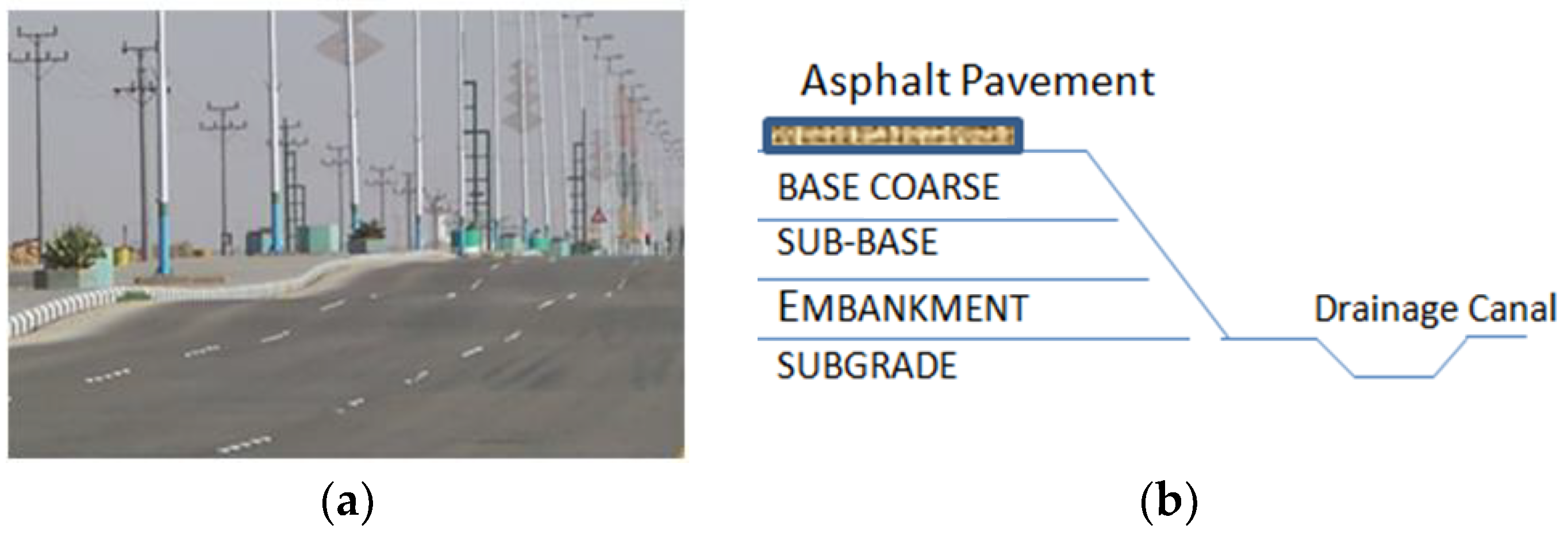
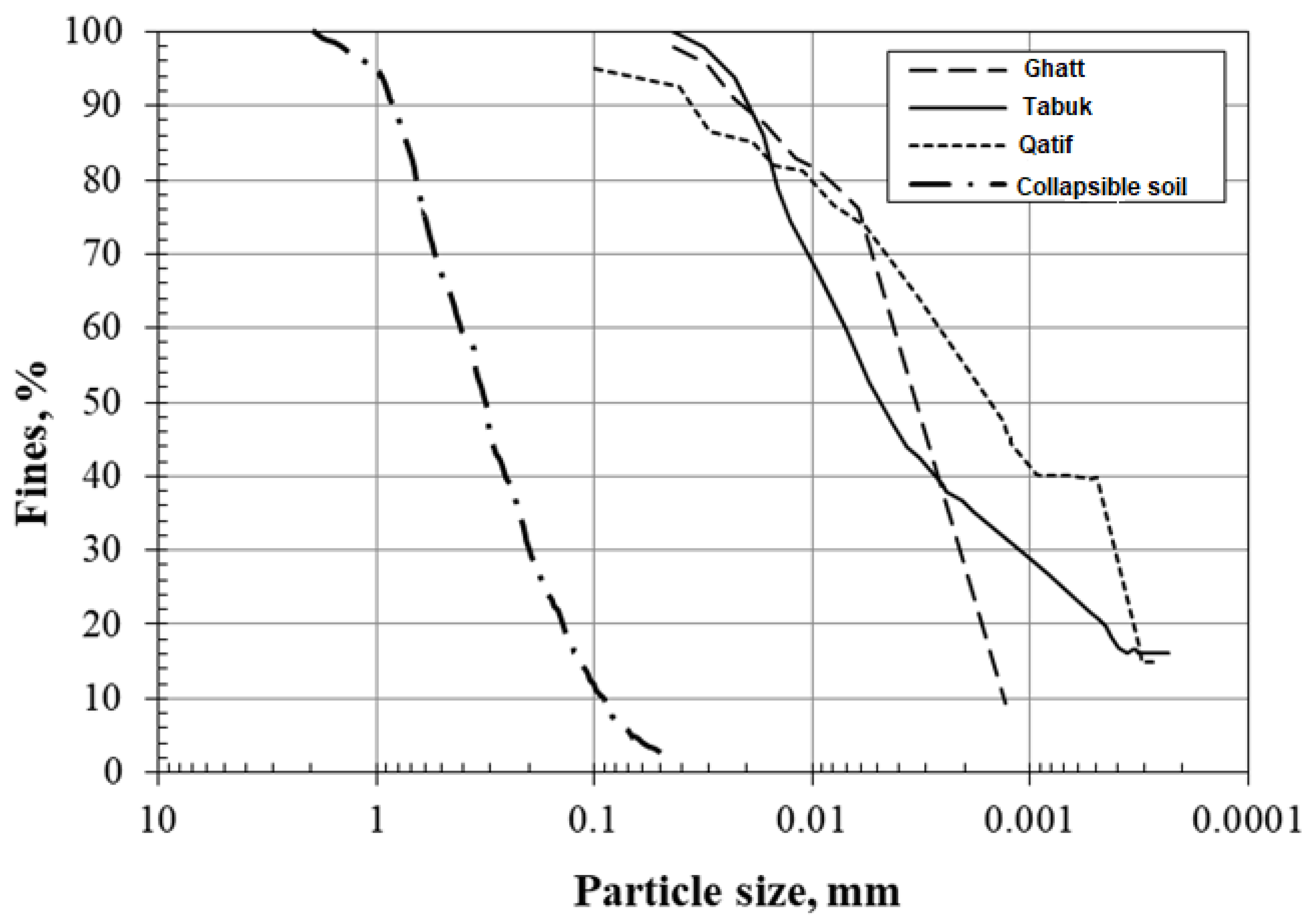

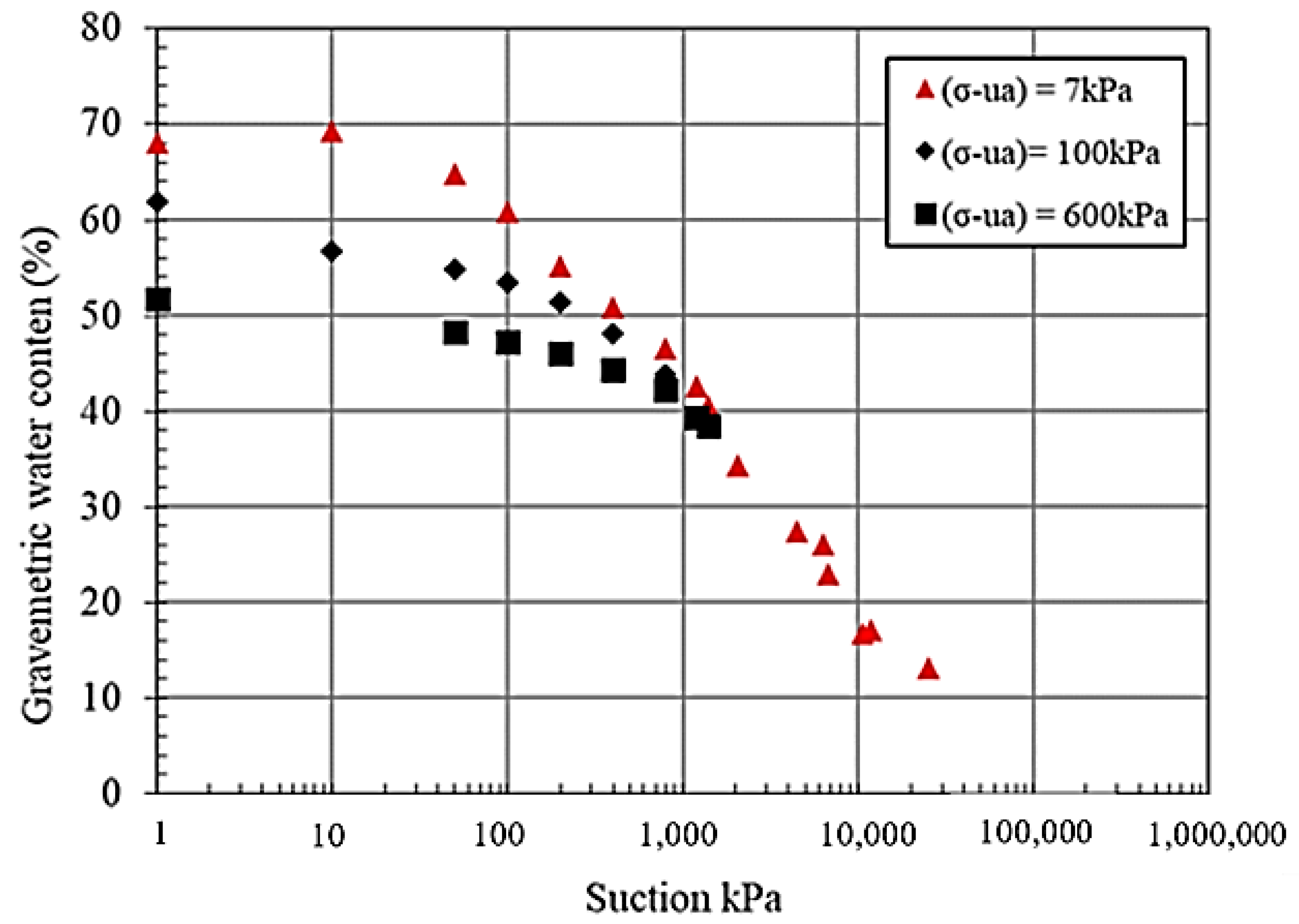
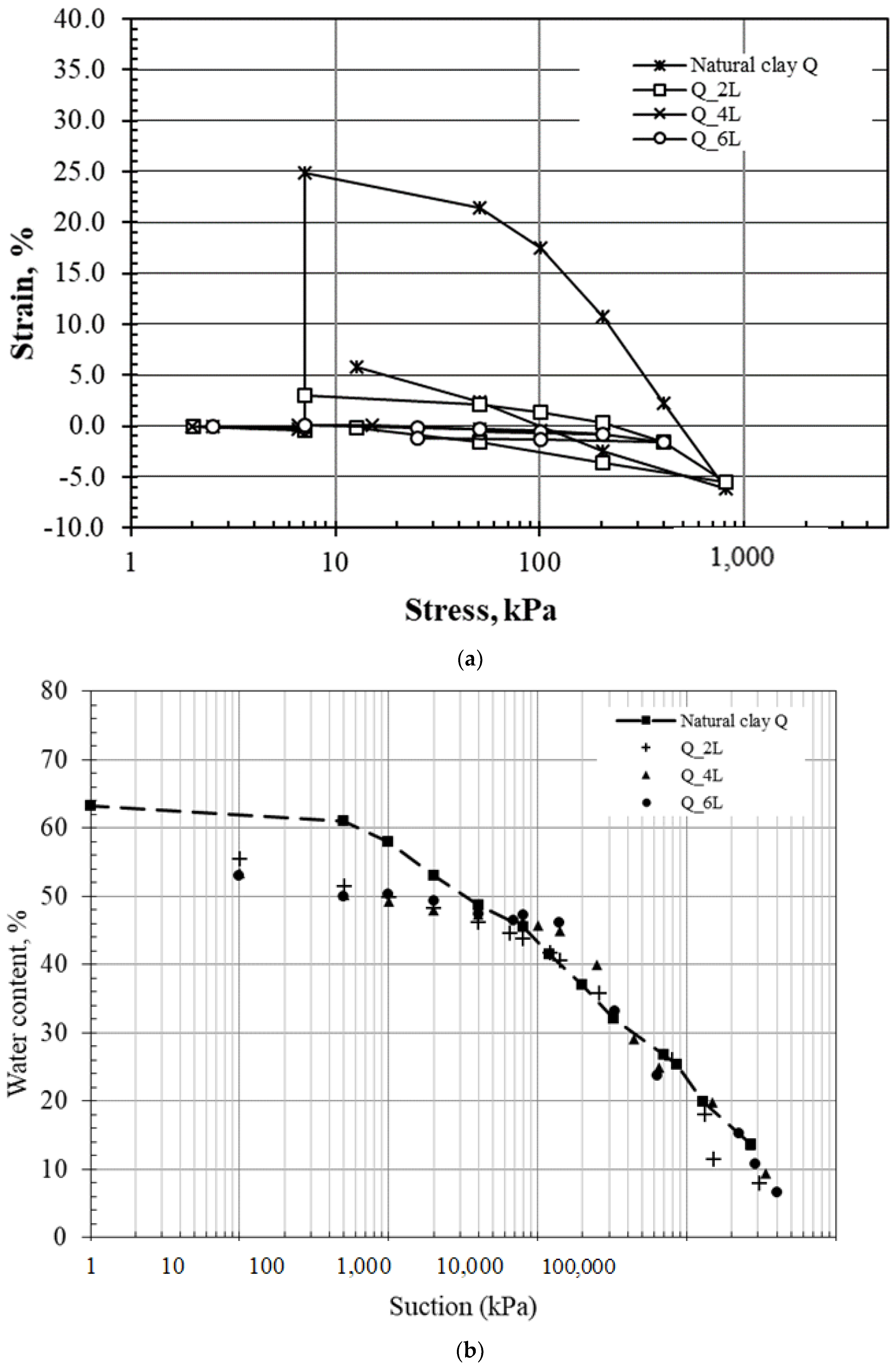
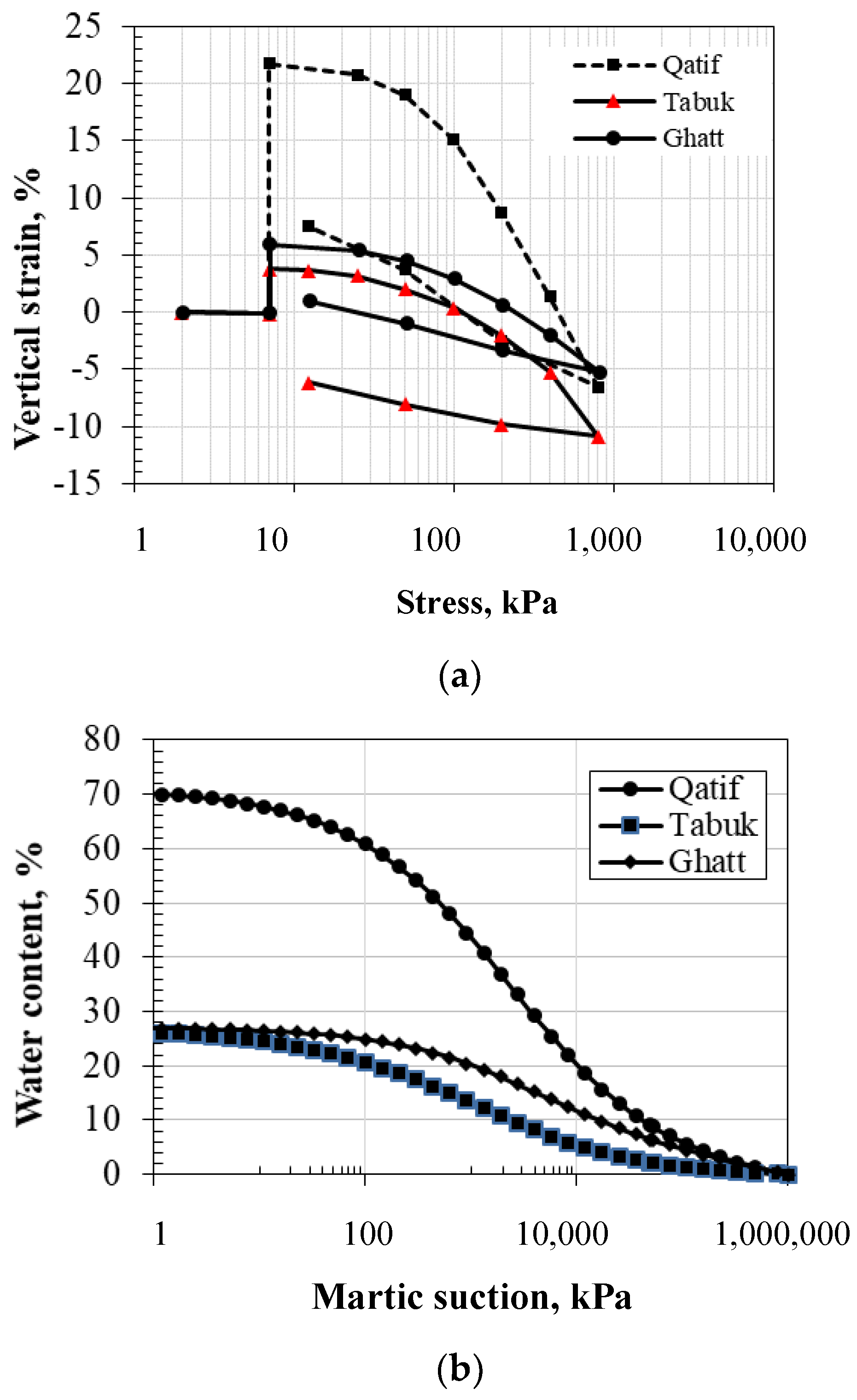
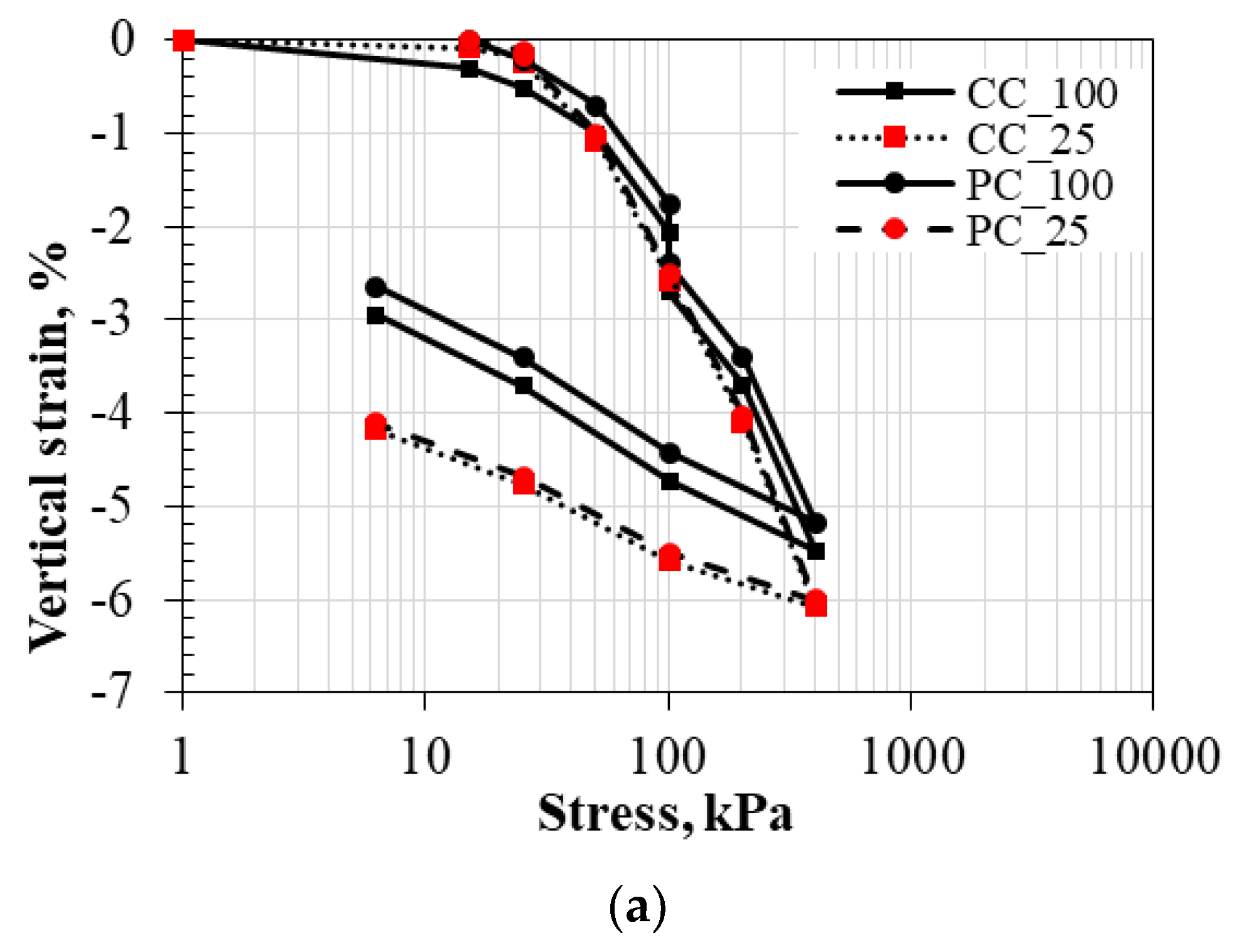
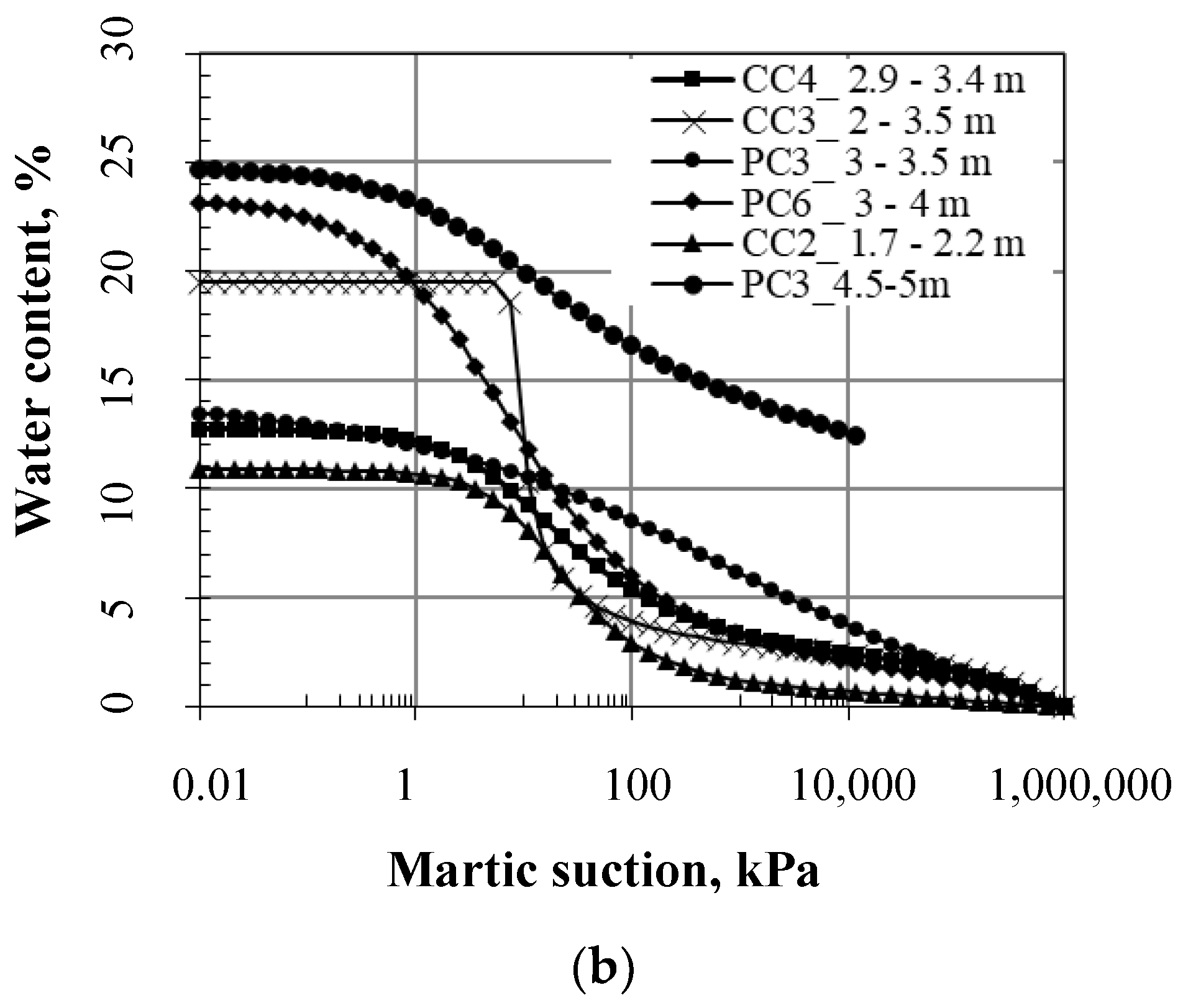
| Soil/Property | Specific Gravity, (Gs) | Liquid Limit, (%) | Plastic Limit, (%) | Shrinkage Limit, (%) | Optimum Moisture Content, (%) | Maximum Dry Density, (kN/m2) |
|---|---|---|---|---|---|---|
| Al-Qatif | 2.7 | 160.0 | 60.0 | 15.0 | 38.0 | 11.8 |
| Ghatt | 2.9 | 59.3 | 33.0 | 14.0 | 24.7 | 16.0 |
| Tabuk | 2.8 | 43.0 | 27.0 | 21.0 | 17.0 | 16.6 |
| Sample Code | Specific Gravity | Initial Water Content (%) |
|---|---|---|
| PC-3 (3.0–3.5) | 2.703 | 8.720 |
| PC-6 (3.0–4.0) | 2.672 | 4.010 |
| CC-4 (2.8–3.4) | 2.637 | 2.200 |
| CC-3 (2.0–3.5) | 2.666 | 3.340 |
| PC-3 (4.5–5.0) | 2.648 | 8.720 |
| CC-2 (1.7–2.2) A | 2.683 | 0.840 |
| CC-2 (1.7–2.2) B | 2.716 | 0.840 |
| Expansion Index (EI) * | Expansion Potential |
|---|---|
| 0–20 | Very low |
| 21–50 | Low |
| 51–90 | Medium |
| 91–130 | High |
| >130 | Very high |
| Collapse Index (Ie)a % | Degree of Specimen Collapse |
|---|---|
| 0 | None |
| 0.1–2.0 | Slight |
| 2.1–6.0 | Moderate |
| 6.1–10.0 | Moderately severe |
| >10.0 | Severe |
Disclaimer/Publisher’s Note: The statements, opinions and data contained in all publications are solely those of the individual author(s) and contributor(s) and not of MDPI and/or the editor(s). MDPI and/or the editor(s) disclaim responsibility for any injury to people or property resulting from any ideas, methods, instructions or products referred to in the content. |
© 2024 by the authors. Licensee MDPI, Basel, Switzerland. This article is an open access article distributed under the terms and conditions of the Creative Commons Attribution (CC BY) license (https://creativecommons.org/licenses/by/4.0/).
Share and Cite
Dafalla, M.; Al-Mahbashi, A.M. Identifying Problematic Soils Using Compressibility and Suction Characteristics. Buildings 2024, 14, 521. https://doi.org/10.3390/buildings14020521
Dafalla M, Al-Mahbashi AM. Identifying Problematic Soils Using Compressibility and Suction Characteristics. Buildings. 2024; 14(2):521. https://doi.org/10.3390/buildings14020521
Chicago/Turabian StyleDafalla, Muawia, and Ahmed M. Al-Mahbashi. 2024. "Identifying Problematic Soils Using Compressibility and Suction Characteristics" Buildings 14, no. 2: 521. https://doi.org/10.3390/buildings14020521
APA StyleDafalla, M., & Al-Mahbashi, A. M. (2024). Identifying Problematic Soils Using Compressibility and Suction Characteristics. Buildings, 14(2), 521. https://doi.org/10.3390/buildings14020521







